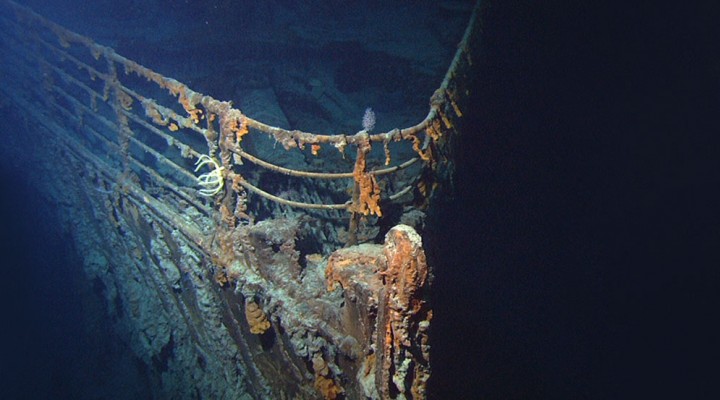EXACT AND NATURAL SCIENCES
Scientists discover how bacteria survive in extreme environments
An international research team, in which Argentine scientists participate, has described for the first time the mechanisms these microorganisms use to live in the depths of the sea.
A great part of the world-famous ship that collided with the an iceberg in 1912 lies at the bottom of the North Atlantic Ocean, at about 12,500 feet down. Needless to say, this huge ship that sleeps in the depths of the ocean is the Titanic, which despite its eternal appearance, it is slowly vanishing due to the action of microorganisms that cannot be seen by human eyes: Halomonas.
Microscopic life is highly flexible and can adapt to extreme environments –excessively cold or hot, acid or basic, salty or with high pressure– which would be lethal for more complex organisms. The microorganisms that colonize landscapes a priori hardly compatible with life are known as extremophiles. It is in the salty, deep- with a pressure level hundred times larger that the atmospheric one-, freezing and dark waters where the Titanic lies that scientists found a new species of bacteria that they called Halomonas titanicae.
To understand these beings’ adaptation to extreme environments remains a challenge and represents a great biotechnological potential –related to, for instance, waste management and the administration of pollution–. For this reason, Víctor Galván, CONICET assistant researcher at the Instituto de Física Enrique Gaviola (IFEG, CONICET-UNC) in Córdoba, participates in an international research team that studies this topic. “Only through a convergence of techniques, perspectives and disciplines it is possible to analyze and describe such a complex phenomenon”, the Argentine scientist affirms.
These bacterium can produce a molecule called ectoine, which helps them to survive osmotic stress, which is produced as a result of great differences in salt and pressure concentrations, in one or the other side of the cellular membrane. The group used advanced neutron techniques available at the Institut Laue-Langevin (ILL, Grenoble, France) to understand the nature of the ectoine-water and ectoine-membrane interaction in the inner part of the Halomonas.
In the water, the molecules move randomly but maintain certain short-range order between a molecule and its neighbor. “The water molecule has an oxygen atom with negative charge density, together with two hydrogens that have positive charge density, forming a dipole. The interaction between two neighbouring water molecules produces a hydrogen bond. The study shows experimentally that the ectoine weakens that bond. That rearrangement in the structure of the water affects greatly the process through which the cell can survive in these environments”, Galván describes.
“These bacterium also have the capacity to take the energy they need to develop as they transform the iron into oxide. They are thought to be the main responsible for the current degradation of the metallic structure of the Titanic and by 2030 they will have reduced it to mountain of oxide powder”, Galvan affirms.
This led to an alert because Halomonas titanicae was also identified as a potential risk for other objects at the bottom of the oceans such as the supporting pilings of the offshore oil platform.
The technique
To study the interactions between the ectoine and thew water molecules, the scientists used neutron beams. “At the ILL institute, scientists have the most intense source of neutrons in the world, where these particles are produced in a nuclear reactor, collected by guides and directed towards the sample. The various interactions the neurons undergo when colliding with matter allows us to obtain information about their structure and dynamics”, the researcher explains. “This is how we could observe that the presence of ectoine modifies the structure of the water that surrounds it, making it conductive to the development of Halomonas and other extremophile microorganisms. This type of study can only be conducted by the use of neuron beams, the researcher adds.
In Argentina, the National Atomic Energy Commission (CNEA) has developed a new nuclear reactor (RA10) that would produce neurons for scientific research, among other functions.
“These great investments in large-scale facilities are vital for scientific progress. The collaboration and participation of our scientific community in interdisciplinary projects and with major institutions such as the ILL is a prerequisite to achieve this goal. Finally, I would like to thank Gabriel Cuello, our Argentine researcher at the ILL, and Giuseppe Zaccai for giving me the opportunity to be part of this important study.”
About the study:
– Giuseppe Zaccai. Institut Laue Langevin – CNRS- CEA-Univ. Grenoble Alpes, France.
– Irina Bagyan. Bitop, Germany.
– Jérôme Combet. Institut Laue Langevin-Institut Charles Sadron, France.
– Gabriel J. Cuello. Institut Laue Langevin, France.
– Bruno Demé. Institut Laue Langevin, France.
– Yann Fichou. CNRS- CEA-Univ. Grenoble Alpes, France.
– François-Xavier Gallat. CNRS- CEA-Univ. Grenoble Alpes, France.
– Víctor M. Galván Josa. Assistant researcher. IFEG.
– Susanne von Gronau. Max-Planck-Institute of Biochemistry, Germany.
– Michael Haertlein. Institut Laue Langevin, France.
– Anne Martel. Institut Laue Langevin, France.
– Martine Moulin. Institut Laue Langevin, France.
– Markus Neumann. Bitop, Germany.
– Martin Weik. CNRS- CEA-Univ. Grenoble Alpes, France.
– Dieter Oesterhelt. Max-Planck-Institute of Biochemistry, Germany.
